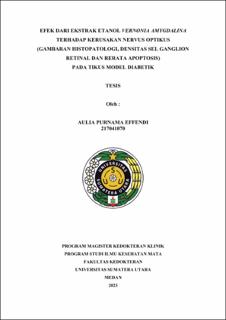Efek dari Ekstrak Etanol Vernonia Amygdalina terhadap Kerusakan Nervus Optikus (Gambaran Histopatologi, Densitas Sel Ganglion Retinal dan Rerata Apoptosis) pada Tikus Model Diabetik
The Effects of Ethanol Extract of Vernonia Amygdalina on Optic Nerve Damage (Histopathological Overview, Ganglion Cell Density, and Average Apoptosis) in Diabetic Rat Models

Date
2023Author
Effendi, Aulia Purnama
Advisor(s)
Sari, Masitha Dewi
Sitepu, Bobby Ramses Erguna
Metadata
Show full item recordAbstract
Background: Diabetes mellitus (DM) is one of the most commonly diagnosed degenerative
conditions worldwide, often resulting in significant negative impacts on the optic nerve due
to chronic hyperglycemia. Hence, there is a need for additional therapeutic modalities
capable of reducing or even preventing the effects of DM on optic nerve damage, such as
the African plant Vernonia amygdalina, which is rich in medical benefits like antiinflammatory
and antioxidant properties. This study aims to determine the effects of
ethanol extract of Vernonia amygdalina on parameters related to optic nerve damage in a
diabetic rat model.
Methods: This experimental animal-based study was conducted on a group of diabetic
Wistar rats induced with streptozotocin and nicotinamide, with ethanol extract intervention
at doses of 100-300 mg/kg body weight per day for five test groups (7 rats per group). The
intervention was carried out for four weeks using Vernonia amygdalina ethanol extract,
followed by the evaluation of histopathological characteristics, ganglion cell density, and
average apoptosis in the optic nerve.
Results: A significant increase in average apoptosis (P<0.05) was observed in the control
group (74.33 ± 4.03) compared to the P2 group (200 mg/kg body weight per day; 47.50 ±
5.96) and the P3 group (300 mg/kg body weight per day; 22.00 ± 1.67). This finding was
nearly equivalent to the untreated sham group (19.67 ± 3.33). Furthermore, the
administration of Vernonia amygdalina extract was only able to maintain normal axons
and Schwann cells in the P3 group, with ganglion cell density appearing loosely packed to
dense at doses of 100-300 mg/kg body weight per day.
Conclusion: The administration of Vernonia amygdalina extract had a positive effect on
the optic nerve in diabetic rats, as evidenced by the average apoptosis findings and
histopathological evaluation.
